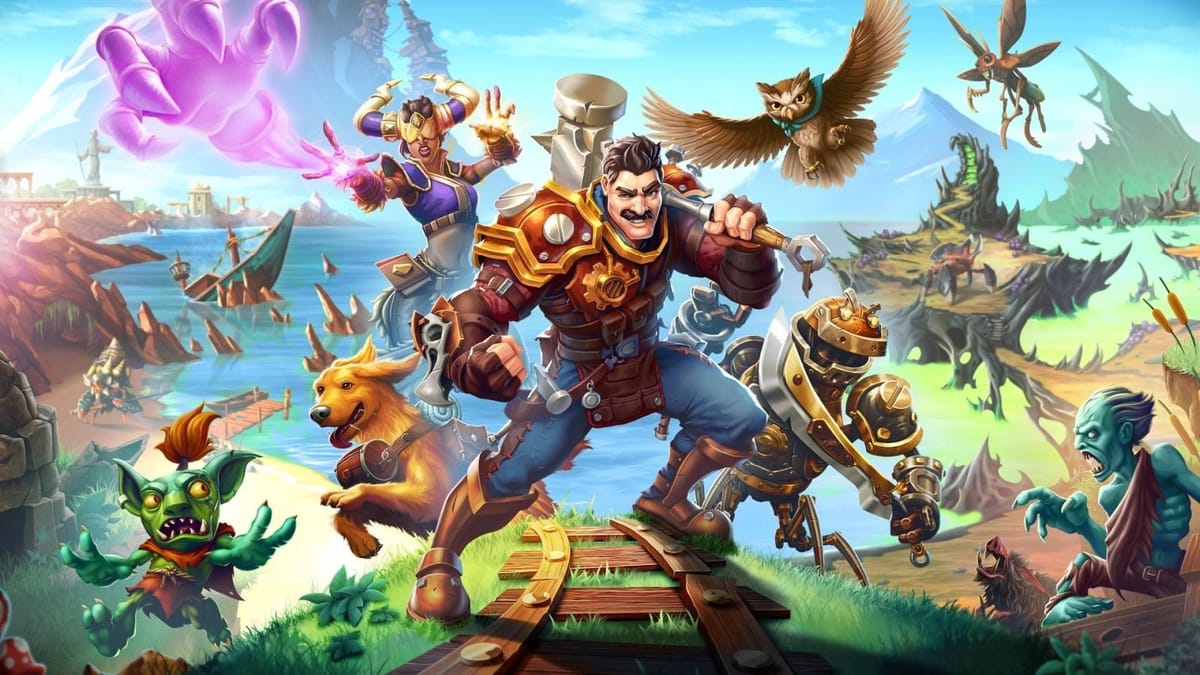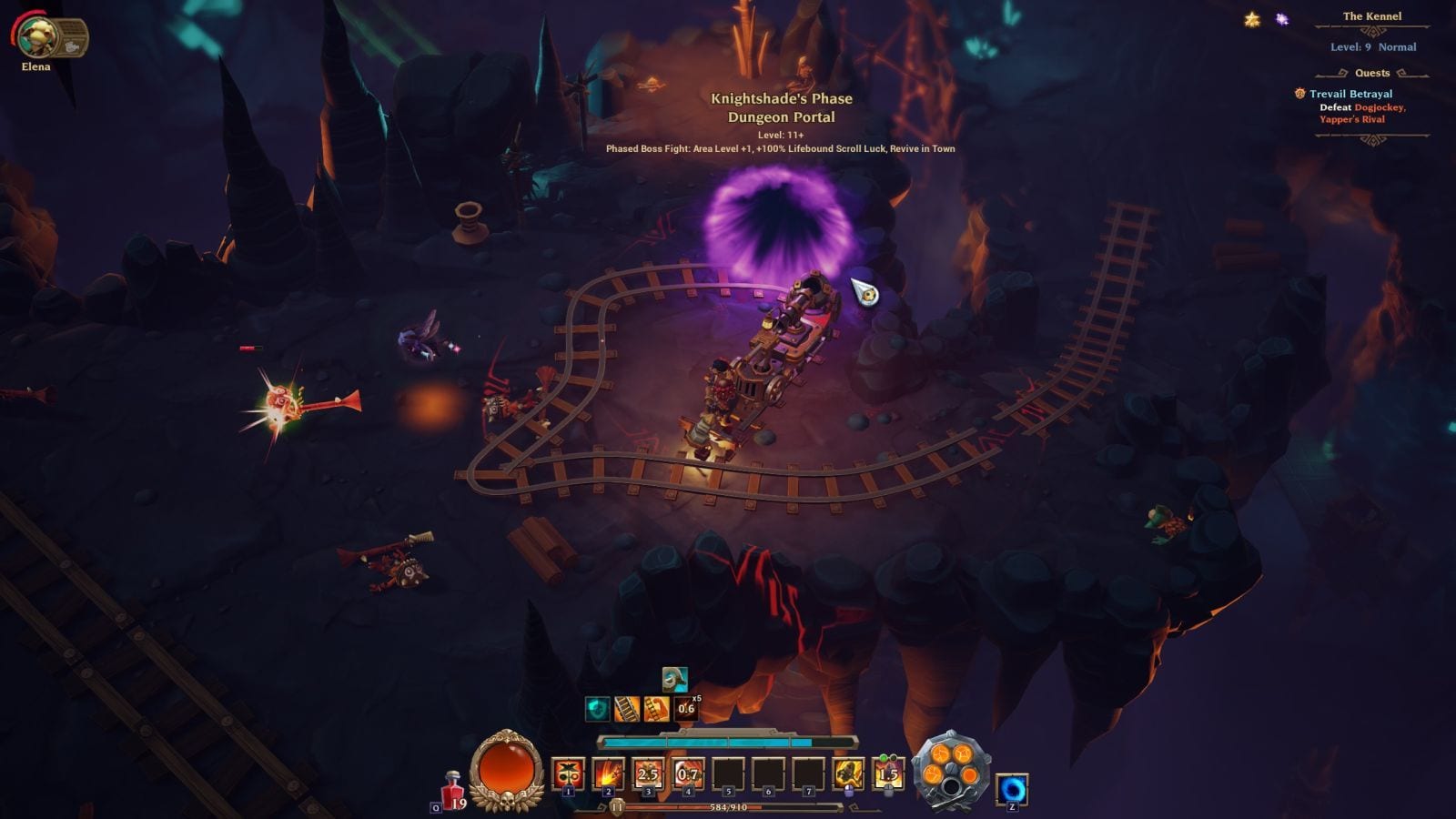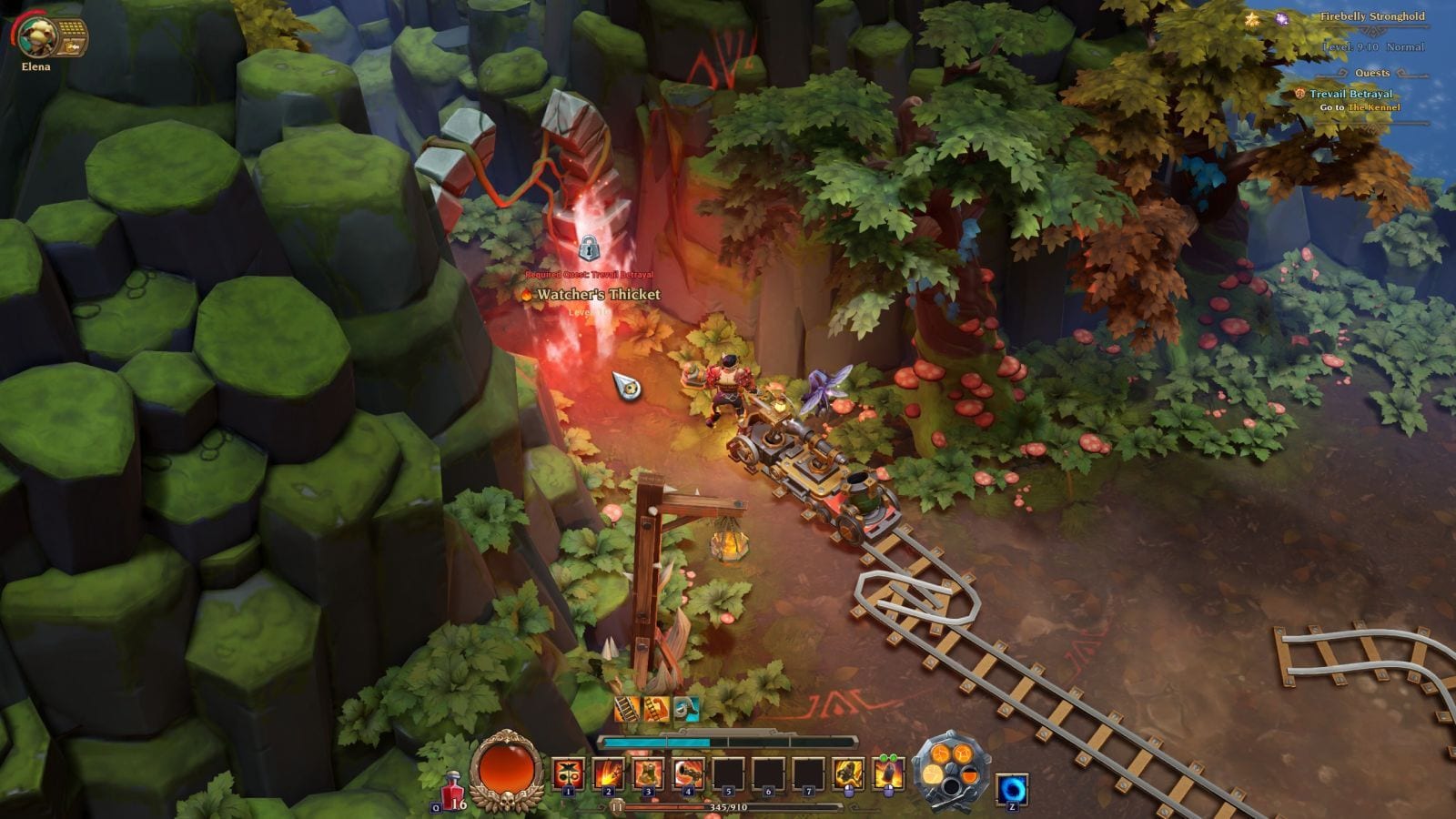
I remember riding in a car headed to a gaming event talking to some fellow press members when one of them casually mentioned that he was playing Torchlight: Frontiers. I wasn’t aware that the game was even on the horizon and, given the number of hours I’ve sunk into its predecessors, I was all sorts of excited. He then immediately dropped my excitement down a mineshaft when he then told me how it was free-to-play and riddled with microtransactions. Fast forward to a few months ago when I heard that Echtra Games had changed the game’s name from Torchlight Frontiers to Torchlight III, and that they were rebuilding it into a fully-featured release with all the trimmings. Excitement restored! Let’s head back to the world of Novastraia and see what’s new.
Torchlight III, like its predecessors, is an action RPG. Selecting from four characters, you set out on an adventure with up to three friends, or flying entirely solo, as you collect loot and defend the world from a brand new threat. The developers have given us four new classes to play, so why don’t we get a closer look at these new protagonists?
Dusk Mages are spellcasters, as the name would suggest, balancing light and dark energies. Light energies boost mana regeneration and generally unleash attacks that help you buff your friends or deal holy damage. Dark energies push in the opposite direction, with enemy debuffs and increased damage, but at greater mana cost. Sharpshooters are exactly what the name suggests, focusing on ranged weapons and picking off foes at a distance. They have an ammo counter that slowly reloads over time in place of a mana pool. Ultimately, if you’ve played a wizard or archer in just about any game, you have an idea of what’s going on here.
Forged are steam-powered modular robots capable of swapping out just about every part of their body. They feature a chest cannon capable of holding off enemies from afar, can wield every weapon, and pick up damaging AoE effects pretty early. They are a fantastic all-arounder, though they have to manage their heat levels lest their powers go inactive for a period of time.
Railmaster is easily the most unique of the four classes. As the name suggests; they run trains. How does that play into Torchlight III? Well, Railmasters can call forth a literal train that will lay tracks and follow them around. Each car can be equipped with different modules like shield generators and mortars. The Railmaster can also wield massive two-handed weapons, making them dangerous in their own right.
With your character class selected you will then choose from five relics that will provide your secondary powers. Bane focuses on poison, Blood Drinker is all about leeching health. Coldheart, Electrode, and Flaming Destroyer align with cold, electrical, and fire damage, respectively. Supposedly these are all associated with a specific weapon type, but I never saw any effect that would prove that out. Herein lies the rub.
These five relics provide much of the major powers you’ll unleash on your foes, meaning you’ll be seeing these powers regardless of which class you’ve picked. It also means if you team up with three other people, odds are good you’ll be seeing these same powers frequently. A system that was meant to differentiate the classes instead pulls the needle so far towards “flexible” that it becomes somewhat arbitrary.
At the outset, you can select from five difficulty levels from Practice to Ridiculous. These affect your chances of getting better gear, how fast monsters move, and how effective your potions are. With your character’s looks, skills, and difficulty selected, you’ll also choose your first pet — a golden retriever, an owl, or an alpaca. These buddies are far from the only choices you’ll have as you play, so don’t agonize over it too much.
My wife and I set out on our adventure, me as a Railmaster, and her as a Sharpshooter. After two hours I turned to her and said “Ok…so what’s the story of this game? Why are we doing any of this?” We agreed that monsters are bad, and gathering resources and gold to fill out our base and buy fresh loot seemed to be the real drivers. To say that Torchlight III is light on story would be an understatement. Not unlike its predecessors, the game features a central hub and you’ll push through 30 or so main areas, and innumerable little side jaunts punctuated by boss fights and frequent trips to town to sell off the cartloads of loot you’ll collect on the way.
One of the ways ARPGs make character choice matter is with restrictions on weapons and armor, and by gating the player with stats that focus on their strengths. Torchlight III has removed both of these for reasons I cannot begin to explain. The stat system is completely eliminated, and now every class can wield every weapon and wear every piece of armor. While the classes will allow you to unleash more powerful techniques with those weapons, it does mean that everything essentially becomes a stat-stick with a cosmetic attached to it.
Moving into skills, they follow a similar pattern to what we saw in Torchlight II, putting points into each of the four buckets — class, subclass, the relic you’ve chosen, and the Legendarium. The Legendarium gives you access to an additional four passive skills that can be added to your arsenal. These can enhance basic things like faster movement speed or better health, but can also provide more exotic buffs like having your pet poison anyone they attack, setting foes on fire when you hit them with lightning, and other more conditions. Half a dozen are unlocked from the start, but there are 111 in total to uncover by finding Legendary items.
Speaking of Legendary Items, the loot system for Torchlight III is very broken at launch. The Diablo-like loot system classifies equipment into the usual colors — grey vendor trash, green magic items, blue is rare, and gold is legendary. The problem is that the game drops such a constant loot waterfall that by level 7 I had already collected seven pieces of Legendary loot. Worse by level 10, I had two of the same staff, two of the same chest pieces, and two of the same pet collars in addition to a pair of pants, a helm, and a sword. When Legendaries drop this frequently it cheapens their value.
Unfortunately, this phenomenon extends to the rarity of monsters. In one small dungeon, I fought seven sets of Elites and one boss — eventually it makes you stop caring about Elites. In other ARPGs, they are a moment when your usual methods won’t do the trick, but the Elites in Torchlight III are basically the same creatures but with a larger health pool and more often an added effect like fire or poison. They are so frequent that they stop being a surprise.
Phase Rifts make a return in Torchlight III. Occasionally you’ll spot a monster called a Phase Beast and killing it will open a Phase Rift. In Torchlight II these were more of a maze that had you solving puzzles and facing scores of foes punctuated by a tough boss battle and a shower of resulting loot. Here they teleport you to a small arena where you skip all of that to face the big boys immediately. During the first chapter of the game, I faced the same boss no less than half a dozen times. I’d kill the phase beast, square off against Snotskin, smacked him down, and did it again 15-20 minutes later. This repetition, combined with the Elites and “Unique” creature problems mentioned above makes it less impactful and more about simply grinding them down. More is sometimes just more, not better. This is made worse as every time you leave an area, the map shrouds again and enemies repopulate.
Pets have gotten a bit of an overhaul in Torchlight III. Rather than fishing for food and growing your pet, you’ll simply rescue them to learn whatever skills they might have. There are twelve total skills to unlock, and a ton of different pets to find (you can store 50 of them), so if pet collections are your jam you might enjoy the new system. If not, they’ll still happily attack enemies and carry loot back to town to sell.
Very early in the game you’ll liberate and occupy a fortress. This fort serves as a central hub for you to respec your character, convert materials you find in the field into usable chunks, and grow various trees that will help you expand your gear luck chances. You can also build decorations, functional items, and pet storage. The functional pieces will let you make offerings to increase fire, gold, or poison boons. You can also construct structures to recpec your skills, though you’ll have to collect “Respecticle” points, which are fairly rare. The problem here being, there’s no sense of accomplishment. I had enough materials to build everything useful by the time I hit level 5. None of that explains how my fort keeps showing up in between nearly every major area which doesn’t make geographic sense — we’ll chalk that up to “magic” I suppose.
I did run into two things that need to be addressed immediately. The first is simply that the constant squeaking coming from my pets begins to grate on my nerves after a short while. A little less frequent, or just muted all together would be preferable. In multiplayer, I ran into a completely toxic environment. I asked some basic questions around game mechanics and got called a “snowflake cuck” and told to go fu…well, you get the picture. There is no mechanism to block these trolls, only to report them, and at launch they seem to be as frequent as Legendaries and Elites.
As you explore and make frequent dump truck hauls of loot back to town you’ll also run into another problem — you can’t enter a space until you have a quest to be there. In other ARPGs the game would adapt to you uncovering a path and roll with it. Here there’s a red light emanating from the transition point with a lock to fully break the immersion.
The underpinnings of Torchlight III as a free-to-play game are very much present, albeit neutered. The “contracts” system rewards you with goodies like gear and cosmetics for your fort, but if it looks like a “log in every day this month” system, which is likely its original form. Similarly, the fort has a system to combine the game’s nearly dozen-strong currencies (wood, metal, minerals, etc.) but these are attached to a timer as they process. You also have a mailbox that allows the system to send you things, but there is no mechanism at launch to trade with your friends, party members, or mail anything to anyone. This is a fatal oversight in a game so heavily reliant on loot acquisition to keep you coming back, and a clear hold-over from a game once aimed at wringing money out of whales.
The game is not without its charm. I’ve killed a Mossrat of Unusual Size and I’ve collected Grapthar’s Hammer, a nod to The Princess Bride and Galaxy Quest, as just two examples — the game is full of them. The art style of the previous game is preserved here nicely, and technical performance is rock solid across the board. The voice acting is decent, albeit highly repetitive, and there is no doubt that the pets are insanely cute.
I guess my primary complaint with Torchlight III is that it feels like the team at Echtra Games has simplified the formula too far. When they shifted gears away from free-to-play to this version, much of the mechanics feel less in service of character development and more to pull players back frequently. In short, it’s more Torchlight, but just a much thinner blend. Your mage can equip a giant oversized two-handed mallet. Your best fighter can use a magical staff that hurls poison everywhere. All players use the same five pool of powers. When everyone can do everything it detracts from the uniqueness of any character; when everyone is special, no one is.
Torchlight III
Mediocre
Torchlight III feels watered down compared to its contemporaries, and worse, its predecessors. The loot is as plentiful as it is unsatisfying. The monsters are a deluge of health bars, removing all sense of threat or purpose. The characters feel so genericized that they can’t transcend past whatever non-specific weapons they may carry. Betrayed by its F2P roots, Torchlight III needed a full rebuild to iterate on its origins, and clearly, that’s not what happened here as it’s simultaneously more of the same, and somehow less.
Pros
- Maintains the unique art style of Torchlight II
- Decent, if repetitive voice work
- Two character classes are kinda unique
Cons
- Repetitive in every single way you could suggest
- Loot drops are too frequent and in no way rare
- Mechanics suffer from F2P roots across the board
- I can’t tell you the story after more than a dozen hours
- Relic pools are recycled across all characters
- Baffling design choices at every turn



